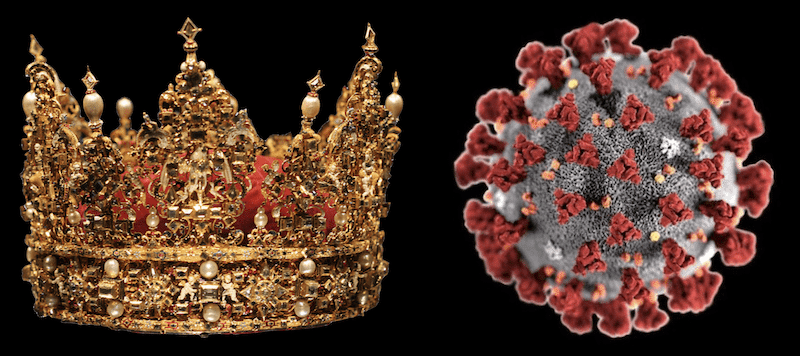Funtabulously Frivolous Friday Five 310
Just when you thought your brain could unwind on a Friday, you realise that it would rather be challenged with some good old fashioned medical trivia FFFF, introducing the Funtabulously Frivolous Friday Five 310 or photographic phFFFF:
‘A picture is worth a thousand words’ is a common phrase originally paraphrased from:
A thousand words leave not the same deep impression as does a single deed.
Henrik Ibsen
A more modern and antithetical interpretation would include the 40th president of the USA.
One picture is worth 1,000 denials.
Ronald Reagan
Question 1
The first one is easy, what pathogen is depicted by the following?
Reveal the funtabulous answer
Coronavirus.
Although ‘corona’ derives from the Latin for crown, I quote the original from 1968:
“Particles are more or less rounded in profile . . . there is also a characteristic “fringe” of projections . . . which are rounded or petal shaped, rather than sharp or pointed, as in the myxoviruses. This appearance, recalling the solar corona, is shared by mouse hepatitis virus and several viruses recently recovered from man.”
A true solar corona:

Reference: Nature Vol 220, November 16 1968
Question 2
Name the disease:
Reveal the funtabulous answer
Lupus erythematosus.
The word ‘lupus’ (Latin for ‘wolf’) is attributed to the thirteenth century physician Rogerius who used it to describe erosive facial lesions that were reminiscent of a wolf’s bite.
“Erythema” simply translated to ‘redness of the skin’, a bit too obvious pictorially. Thus this wolf is actually a ‘red wolf’, native to the north American continent.
References:
- DermnetNZ – lupus for a great overview and more images
- Lupus foundation of America – History of Lupus
- Red Wolf – The National Wildlife Federation
Question 3
What dance is named after this martyr?
Reveal the funtabulous answer
Saint Vitus’ Dance (aka, Dancing mania, Sydenham’s chorea)
The original descriptions of chorea (from Ancient Greek ‘choreia’, meaning ‘dance’) date from the Middle Ages, when an epidemic of ‘‘dancing mania’’ swept across Europe. The condition was initially considered a curse, but was named ‘‘Saint Vitus’s dance’’ because afflicted individuals were supposedly cured if they touched churches which contained relics (bones) of Saint Vitus.
In the 17th century, Thomas Sydenham provided an accurate description of what he termed chorea minor, he also described rheumatic fever but did not associate it with chorea.
Saint Vitus himself was the son of a pagan Sicilian senator whom became Christian and later died in 303 AD during Diocletian’s persecution of Christians. In the late Middle Ages, people in Germany celebrated the feast of Vitus by dancing before his statue. It led to Vitus being considered the patron saint of dancers and of entertainers in general.
Reference:
- Vale T, Cardoso F. Chorea: A Journey though History. Tremor Journal. 2015
Question 4
Which disease was named after this ‘cranky’ fellow:
Reveal the funtabulous answer
‘Mad’ Cow Disease, nee bovine spongiform encephalopathy (BSE).
Although our cantankerous cow here is a bit mad, he is not mad in the true sense of disordered CNS of affected cows. Our ornery bovine friend has the capacity to pass his prion disease to us through the consumption of beef products. Prion diseases are fatal, transmissible spongiform encephalopathies (TSEs) that affect humans and other animals. They are associated with the deposition of misfolded forms of the prion protein (PrPSc) in the central nervous system (CNS) that propagate by seeding the multimerisation and conformational conversion of normal cellular prion protein.
Human prion diseases include Creutzfeldt-Jakob disease (CJD), fatal insomnia, Gerstmann-Sträussler-Scheinker syndrome, kuru, and variably protease-sensitive prionopathy.
Reference:
- Orrú C et al. Prior seeding activity and infectivity in skin samples from patients with sporadic Creutzfeldt-Jakob disease. Sci Transliterates Med. 2017;9(417):eaam7785
Question 5
I would love to own any of these, but not get the disease (although I’m too old to get either…)
Reveal the funtabulous answer
Kawasaki Disease:
Tomisaku Kawasaki 川崎 富作 (1925 – ) saw his first case of the paediatric vasculitis that would come to bear his name in January 1961, his realisation of it as a new entity occurred one year later when seeing an identical case. Over the next 5 years, Kawasaki gathered a total of 50 patients suffering from ‘acute febrile mucocutaneous syndrome with lymphoid involvement with specific desquamation of the fingers and toes’ and first published this in Japanese in 1967.
Kawasaki disease (KD) is the second most common paediatric vasculitis after Henoch Schonlein purpura, and is the most common cause of acquired heart disease in children, in developed countries, causing coronary artery aneurysms (CAA).
Approximately 85% of cases occur under 5 years of age, peak age 18-24 months. Children under 6 months and more than 5 years old less frequently develop KD, however are more likely to develop CAA. The disease often presents without all diagnostic criteria and can pose a significant diagnostic challenge. Generally it is easier to think of KD as a generalised mid-sized arteriopathy, instead of trying to memorize all the diagnostic criteria, but for completeness here they are:
Fever persisting for at least 5 days, plus 4 of the 5 criteria:
- Conjunctivitis, non-purulent.
- Lymphadenopathy: cervical, tender.
- Rash: polymorphous.
- Oral: red lips and strawberry tongue.
- Hands and feet: Hyperaemia and painful oedema. Later desquamation.
References:
- RCH Guidelines for Kawasaki disease
- Needing a Diagnostic Kick-start. LITFL
- Burns J. History of the worldwide emergence of Kawasaki disease. Int Jr Rheumatic disease. 2017
…and finally
Simplest most visual overview of COVID-19 | Coronavirus: Epidemiology, Pathophysiology, Diagnostics

FFFF
Funtabulously Frivolous Friday Five
Dr Mark Corden BSc, MBBS, FRACP. Paediatric Emergency Physician working in Northern Hospital, Melbourne. Loves medical history and trivia...and assumes everyone around him feels the same...| LinkedIn |





